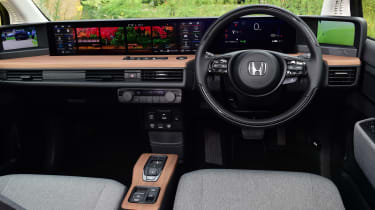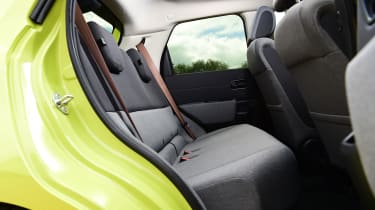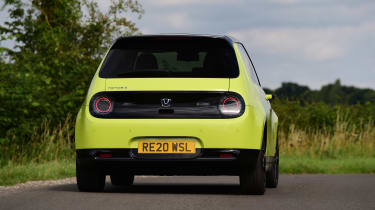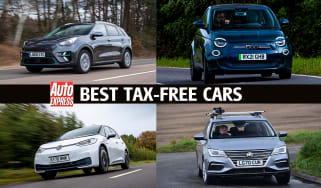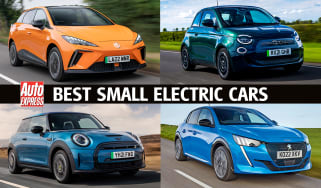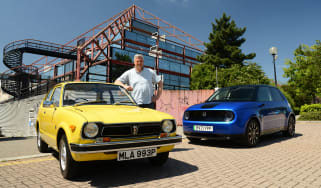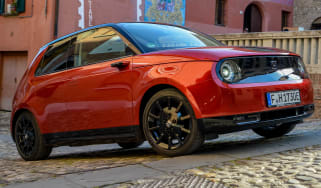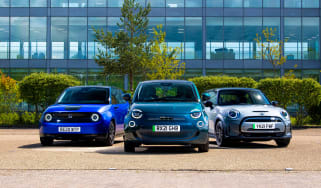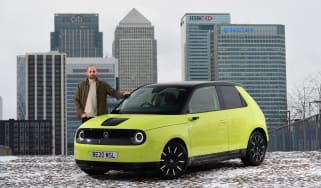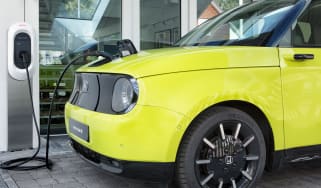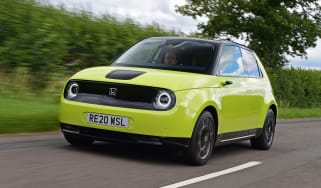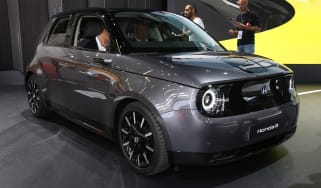Honda e review
The retro-styled Honda e provides a cool, classy take on the small electric car, although it's expensive to buy

PCP finance available
Honda is known for its engineering excellence and practical design touches, but style has never been a particular strong point. The Honda e changes that with a retro theme that should attract buyers, while helping the car stand out in an increasingly crowded electric city car segment.
The Honda e is instantly recognisable, achingly cool and full of the latest tech. Customers will have to pay handsomely for the privilege of owning one and the relatively limited range may prove to be a deal-breaker. But, if you’re in the market for a small, fun and classy electric car, the Honda e is definitely one to consider.
About the Honda e
Honda delivered the first mass-produced hybrid vehicle in 1999 with the launch of the rather odd-looking two-seater Insight, and has rolled hybrid tech out across its range in the years since. But, it took until 2020 for the first pure electric Honda car to emerge in the shape of the e hatchback.
The small, five-door EV is priced from around £34,000 and is aimed squarely at taking sales from the MINI Electric, the PSA Group’s Peugeot e-208 and Vauxhall Corsa-e, plus the electric Fiat 500.
Power for the Honda e comes from a 35.5kWh lithium-ion battery, with a rear-mounted electric motor that drives the rear wheels. This set-up provides either 134bhp or 152bhp, with a maximum range of up to 137 miles.
More reviews
Car group tests
Long-term tests
Road tests
There are just two equipment levels - Standard and Advance, with the entry trim matched to the lower powered car and the top-spec kit only offered in tandem with the more potent power option.
Honda hasn’t scrimped with on-board tech in the e - there is an 8.8-inch display in front of the driver, along with two 12.3-inch screens taking care of the infotainment system. The system operates much like a smartphone, with large tile icons for various features (from power flow to activating the car’s onboard wi-fi hotspot), pinch-and-zoom functionality and the ability to switch information from one screen to another.
In typical Honda fashion, and contrary to other manufacturers’ product strategies, the e was developed on a purpose-built, all-new platform which won’t be used on any other model. So, it’ll come as no surprise that Honda’s electric supermini fulfills its brief pretty well - it’s quick and nimble around town, easy to park, comes loaded with safety kit and, of course, will provide you with low running costs.
Engines, performance and drive
The Honda e delivers exactly what you want from a capable supermini. It drives nicely, it’s comfortable and refined, while also being able to inject a sense of fun into even the shortest of journeys.
It gets independent suspension all round, so the ride is pretty settled, although it can get a little fidgety on undulating roads. That wheel-at-each-corner stance makes the car feel quite stable at high speeds, although it should be said that the e feels completely refined around town - it’s just about as agreeable a way to navigate urban roads as any other noisier fossil fuel rival.
There is a good amount of feel through the steering wheel - it’s light, but quick and helps make the small EV nimble and easy to manoeuvre in town driving. Of course, being an EV, there’s no intrusive noise from a combustion engine - in fact the e is very quiet indeed with very little motor whine and no wind whistle.
The only real niggle with the driving experience is the unusually high number of brake-regeneration modes. While this feature does allow the battery to harvest as much energy as possible, it does seem like overkill in such a city-based car and we’d expect most owners to never fiddle with the settings.
Engines, 0-60 acceleration and top speed
The 35.5kWh battery supplies either a 134bhp or 152bhp electric motor driving the rear wheels, with a healthy 315Nm of torque. Despite all that typical EV grunt, the e doesn’t feel as strong as some rivals, although 0-62mph is still taken care of in 9.0s and 8.3s, respectively, and top speed is limited to 90mph.
It’s definitely quick enough for the needs of most urban drivers, while there’s always the Sport mode to play with which sharpens throttle response slightly for when the road opens up.
Range, charging and running costs
The obvious advantage of driving an all-electric vehicle is that overall running costs should be much lower when compared to the fossil-fuel competition. However, Honda has realigned prices for the e range, which means it's now more expensive to buy than the MINI Electric, Nissan Leaf and Renault Zoe. Honda's finance deals also require fairly hefty monthly repayments, normally over a 36-month period.
Charging options appear more positive - plug into a rapid charger and you’ll be able to take the e battery from zero to 80% in 30 minutes, while using a 7.4kW home wallbox takes a little over five hours.
You also get a three-pin cable, although it’s really only suitable as a back-up or for emergency use, because a full charge this way takes almost 15 hours.
Honda claims the maximum range for the e is 137 miles, although if you opt for the Advance trim with optional 17-inch wheels, the range falls to 131 miles. Despite these figures being generated under the stricter WLTP testing, the actual real-world range will depend on factors such as your own driving style, the weather (batteries don’t function as well in colder temperatures) and if you’re depleting the battery power by using systems such as air conditioning and the sat-nav.
Insurance
The standard 134bhp e version sits in group 25 for insurance, so premiums won’t be too cheap for a city car. The more powerful 152bhp variant is in group 29. The MINI Electric rival starts from group 22, rising to group 23, so should be less expensive to cover.
Depreciation
Although the Honda e hasn’t had much time to settle into the used market, data suggests that the Japanese supermini will hold onto around 49 per cent of its original value after a typical three-year/36,000-mile ownership period. By comparison, the MINI Electric fares a little better with 58 per cent retained over the same period.
Interior, design and technology
Honda has definitely looked to its past in producing the e supermini. It takes design cues from the first ever Civic, although with a funky, modern twist.
Pull on the deployable, Aston-Martin-like door handle and step inside and, just like the exterior, the cabin is refreshingly different. Wood trim stretches across the top of the entire dashboard and above it sit three large TFT screens.
There are also two six-inch displays - one at either end of the dash showing images from the door-mounted cameras that replace conventional wing mirrors. The screens are well positioned and the picture quality is sharp, with very little digital delay in showing what’s happening behind you.
The entry-level trim includes climate control, a reversing camera and heated front seats, along with Bluetooth, a DAB radio, Apple CarPlay and Android Auto. Moving up to the Advance trim adds luxuries such as a multi-view camera, a heated steering wheel and Honda’s Parking Pilot - where, at the press of a button, the car will identify a suitable spot before reversing in for you.
The tech-fest continues with the voice-activated ‘Honda Personal Assistant’ which helps you locate specific information or features such as the weather forecast, your chosen music or a sat-nav destination point. There is also an HDMI connection beneath the dashboard, allowing passengers to connect up a games console, while a smartphone app that enables owners to monitor the battery status and create a digital ‘key,’ can be shared with others to open and start the car.
Sat-nav, stereo and infotainment
The operation of the infotainment system is mostly slick - the screens are bright and the sharpest we’ve seen in a Honda. The response to your inputs is good, but while the gallery view you get from the dash-wide display is appealing, the left panel is a bit of a reach from the driver’s seat.
The display is made up of an 8.8-inch TFT panel in front of the driver showing data such as speed and efficiency, with two 12.3-inch touchscreens in charge of the infotainment. The layout of the on-screen menus is tidy, with neat tiles for the main functions, while loading times are decent enough.
We particularly like the big on-screen button that performs a charging station search, although the resolution of the Honda’s display isn't as high as that in rivals such as the Fiat 500 or MINI Electric, so the graphics looks slightly fuzzy in comparison.
The rear-view cameras work well – once you’ve got used to focusing your eyes on a nearby screen. An optional extra includes a camera for the central rear-view mirror, activated by a switch. However, it still functions as a conventional mirror, which by design must be reflective – this means that the display is prone to glare.
The Advance-trim cars include a premium audio system with eight speakers, instead of the standard car’s six-speaker set-up.
Practicality, comfort and boot space
The Honda e is only a four-seater, but it has enough space for most every day trips and the interior is nicely executed. The materials used are mostly of high quality, and the seats are comfortable and supportive.
The e is reasonably practical, too - there are some useful storage bins, a pull-out cup holder within the centre console and thanks to a flat floor, it feels roomy up front. The e includes a small under-floor space for storing items, although Honda provides two separate bags for the charging cables.
One of the key advantages of using a unique, purpose-built EV platform, along with a rear-wheel drive set-up, is that the e is gifted with a supremely practical turning circle of just 8.6 metres - so it's able to manoeuvre easily in busy streets.
However, it will be important for customers to think carefully about the e’s limited range. Honda claims the small EV will travel up to 137 miles on a full charge, but in real-world driving this will potentially be difficult to achieve, and you could be looking more towards the 100-mile mark.
It’s kind of a split decision - if you have access to a 7kW home charger, have a small family or a second car and only have short urban commutes to contend with, then the Honda e’s charm and practical city-car credentials will be hard to beat. But, rivals such as the Renault Zoe and Vauxhall Corsa-e can go much further on a single charge, while the MINI Electric is cheaper to buy.
Size
The Honda e is 3,895mm long, 1,750mm wide and 1,495mm tall. By comparison, a Peugeot e-208 is a little longer and wider, although isn’t as tall as the e.
The Honda is a touch longer and narrower than the MINI Electric, but its taller roofline adds 80mm in height over the MINI.
Leg room, head room & passenger space
The e offers more space than in a Peugeot e-208 and the Honda comes with five doors compared with the three-door-only MINI. Rear passengers enjoy a decent level of space - the tall roofline allows you to sit upright and leg room is fine.
Boot
The Honda e’s electric motor is positioned under the boot floor, which results in a rather poor load capacity of 171 litres. Again, for what most customers will want from the small EV this will probably be adequate, but the MINI offers 211 litres, while the Nissan Leaf family hatch has an even larger 435-litre boot.
Reliability and safety
The Honda e features a host of kit and driver aids, designed to make the driving experience as safe as possible. An array of airbags are joined by more active equipment such as adaptive cruise control, a lane keep assist system, autonomous emergency braking and traffic sign recognition. The Advance trim adds blind spot warning and cross-traffic monitoring, which helps detect vehicles approaching from the side when reversing out of a parking space.
However, Euro NCAP awarded the Honda e a four-star safety rating (out of five), which isn't quite up to the top five-star score of the Nissan Leaf. Euro NCAP noted concerns around protection for the driver and front passenger in various crash-test simulations.
The Honda e didn't feature in our Driver Power satisfaction survey, although Honda itself finished in 6th place out of 29 manufacturers, with overall reliability across the range a strong feature.
Warranty
Honda offers a three-year/90,000-mile warranty for its vehicles, which is a generous mileage limit when compared to some rivals. The manufacturer also allows customers to purchase extended cover for a further two years.
Honda e batteries come with an eight-year/100,000-mile warranty (whichever comes first), and the manufacturer also guarantees a minimum state of charge of 70% through its warranty period.
Servicing
Honda offers five-year service plans for the Honda e, helping to spread the cost of scheduled maintenance.




